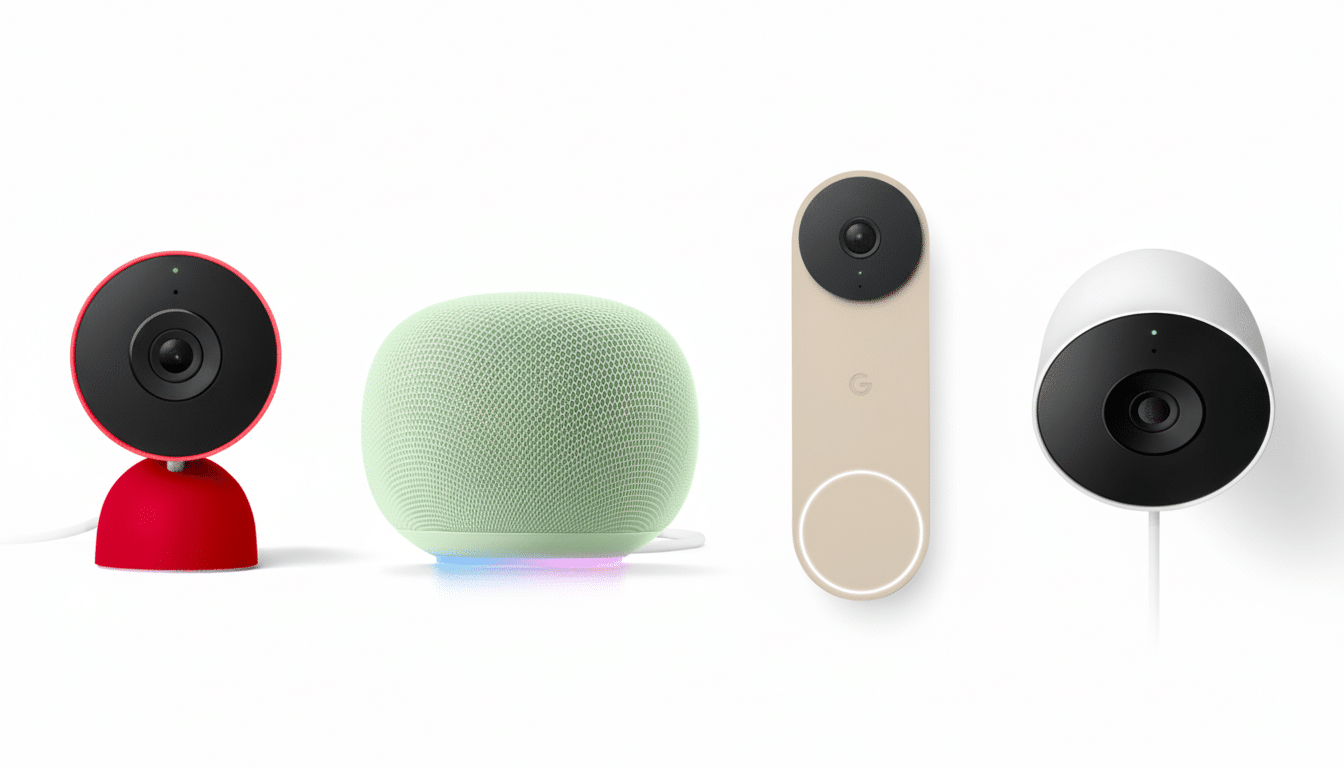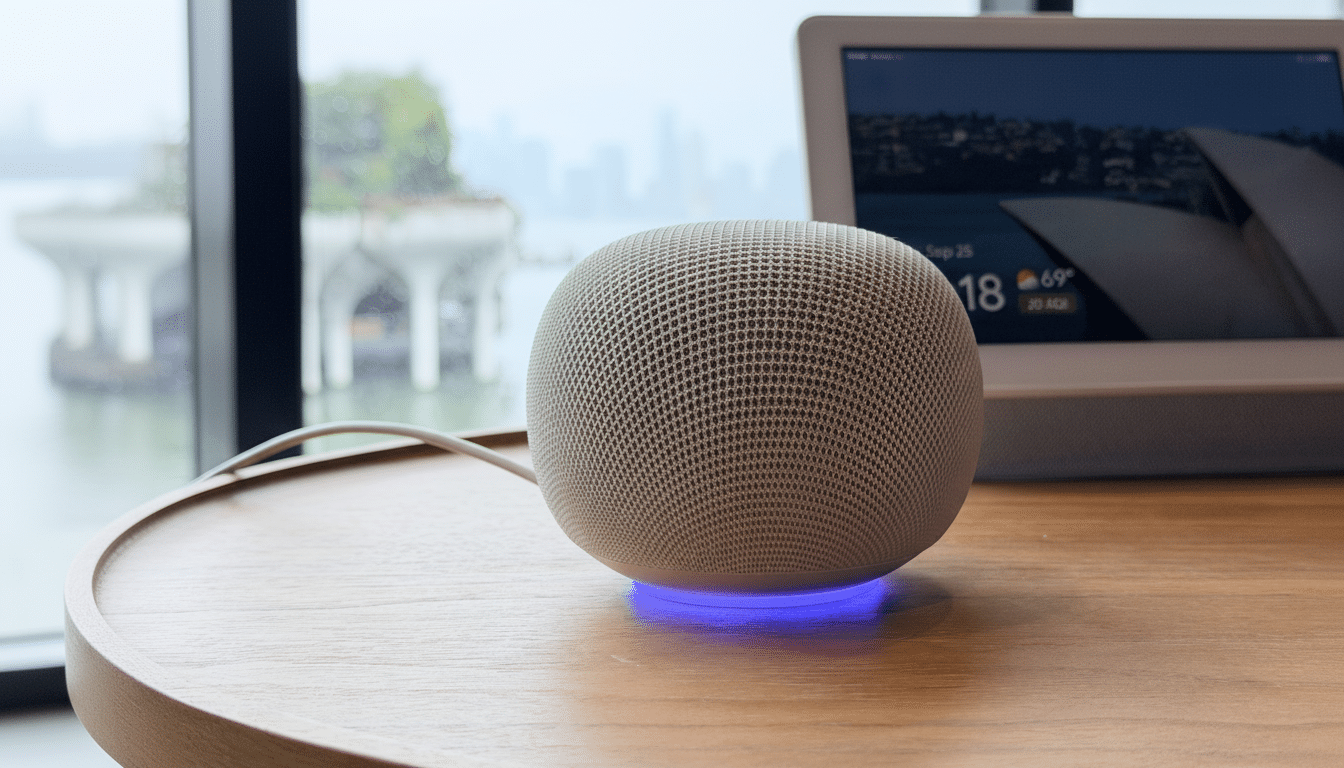Google’s new Home Speaker is a distinctive presence the first time that you see it. It also looks like a well-made product and sounds surprisingly full for its size — Gemini is the centerpiece experience here. But after some hands-on time, a larger question looms over it than one of soundstage or AI trickery: Who is this speaker for and why now?
Design and first impressions of Google’s Home Speaker
The fabric-jacketed cylinder feels like a natural outgrowth of Google’s soft industrial design language. It’s got a tight enough weave, feels swell enough to the touch and (thanks to those more daring color options) does more than decor duty — they help ensure that the light ring at the base pops when Gemini responds. The construction is clean and the controls are straightforward. It’s hardware that looks at home in a kitchen or bedroom, a den or an office — without attracting unwanted attention.
- Design and first impressions of Google’s Home Speaker
- What changes with Gemini Live on a dedicated speaker
- Sound profile and real-world placement realities
- Making the TV pairing pitch for better everyday sound
- Value and competition in the $100 smart speaker tier
- So who is this Google Home Speaker really for

It’s tuned for 360-degree audio, hoping to fill a room instead of firing a narrow beam at one listening position. That approach is similar to what rivals including Amazon have done with their spherical Echo models. Out in the open, that omnidirectional profile spreads vocals and mids all around, with surprisingly decent bass for a single-driver smart speaker. But in fast A/B listening, it prioritizes clarity and warmth over a chest-thumping low end — perfect for podcasts, news briefings and background playlists.
What changes with Gemini Live on a dedicated speaker
The headline difference is Gemini integration. You get natural, conversational give and take — without having to script commands stiffly — that reduces friction in everyday use. Context carryover is much better; you can request a dinner playlist, then narrow it down by mood, and then pivot to follow up on an event from your calendar without losing the thread. The demos had low enough latency that they felt fluid.
The challenge is differentiation. Older speakers will get a wider range of Gemini capabilities, Google says, and certain newer models — including the Nest Audio — will support Gemini Live. That’s good for the ecosystem, but it leaves fewer reasons to buy new hardware when your old speaker is about to get smarter anyway. The Home Speaker is meant to be the best embodiment of that experience, but Gemini won’t be the only thing to speak its language.
Sound profile and real-world placement realities
Omnidirectional sound is as much a philosophical choice as an engineering one. A lot of people like to park their speakers near a wall, which can cause reflections and boundary gain that shade the result. “Ideally the speaker is used in a secondary zone as it’s not designed to compete directly with the music system, but instead to provide background music elsewhere in your home. With that said, placement does matter: put it out of the way on a sideboard or beside an island unit and it sounds more balanced; nestle against a wall and both bass can loosen and treble can soften.” And there’s no mention of the advanced room correction incorporated into pricier Sonos and Apple products, so what you hear will depend in part on your room.
With that said, this is a significant improvement over dinky puck speakers. The voice is still intelligible at low levels, and the unit remains relaxed even at moderate volumes without a hint of grain. Stereo pairing and multi-room playback — features that are generally found throughout Google’s lineup by way of Chromecast — may attract those who are outfitting a whole home with audio, although the value proposition shifts if you already own a pair of Nest Audio speakers.
Making the TV pairing pitch for better everyday sound
Google’s most strait-laced tale is going to be told in living rooms: add a Home Speaker to a Google TV Streamer for an easy, cable-busting audio upgrade. It’s a smart use case — fewer boxes, rapid setup and tight system control by voice. Dialogue-forward tuning works well for streaming shows and sports highlights, while hands-free voice for search and transport controls is genuinely useful.

It is the competitive baseline that is the caveat. Most Google TV Streamer owners probably already own a soundbar or bookshelf speakers, and the upgrade calculus becomes more difficult if your household has made an investment elsewhere. A single smart speaker will do wonders for TV sound, but it’s no substitute for a dedicated bar with a subwoofer to really make your ears ring.
Value and competition in the $100 smart speaker tier
With an announced price of $100, the Home Speaker enters a hotly contested tier. Amazon’s Echo often sells for well under its sticker price during promotions, while Sonos and Apple get to charge more by offering room tuning and richer sound. Google’s own Nest Audio is frequently discounted, and with Gemini Live around the corner for that model, a lot of potential buyers will look at the discount sticker and shrug at new hardware.
Market context matters. Analyst firms like Canalys and Parks Associates have followed a hardening smart speaker space, with penetration in the United States hovering around half of broadband households and shipment growth decelerating after early pandemic surges. In developed markets, new sales are typically replacement-based, not first-time purchases. That exacerbates the burden on good reasons to upgrade beyond “now with AI.”
So who is this Google Home Speaker really for
If you’re all in on Google and you want a relatively clean, conversational Gemini experience from a small speaker, this is the pick for you. It’s a good option, too, for the renter and small-space dweller who craves a clean setup and voice-first control. The TV pairing angle is significant if you yearn for better-than-TV speakers but don’t want the floor space of a soundbar.
If you already have a Nest Audio (or more than one) and most of them will get Gemini Live, feel no rush to change. Audiophiles are still better off with a dedicated soundbar, stereo amp or high-end smart speaker. And if you straddle ecosystems or chase the best sale prices, competitors will tease you with discounts that undercut the headline sticker.
The bottom line, though, is this: the Google Home Speaker not only sounds better but also looks better and makes Gemini a little less of an extra feature and more of a part of your life.
But in a market where “good enough” gear already exists in countless rooms, its success will depend on how much people value a more natural AI assistant and an all-in-one design that doesn’t scream out Black Mirror at the $100 price point.

